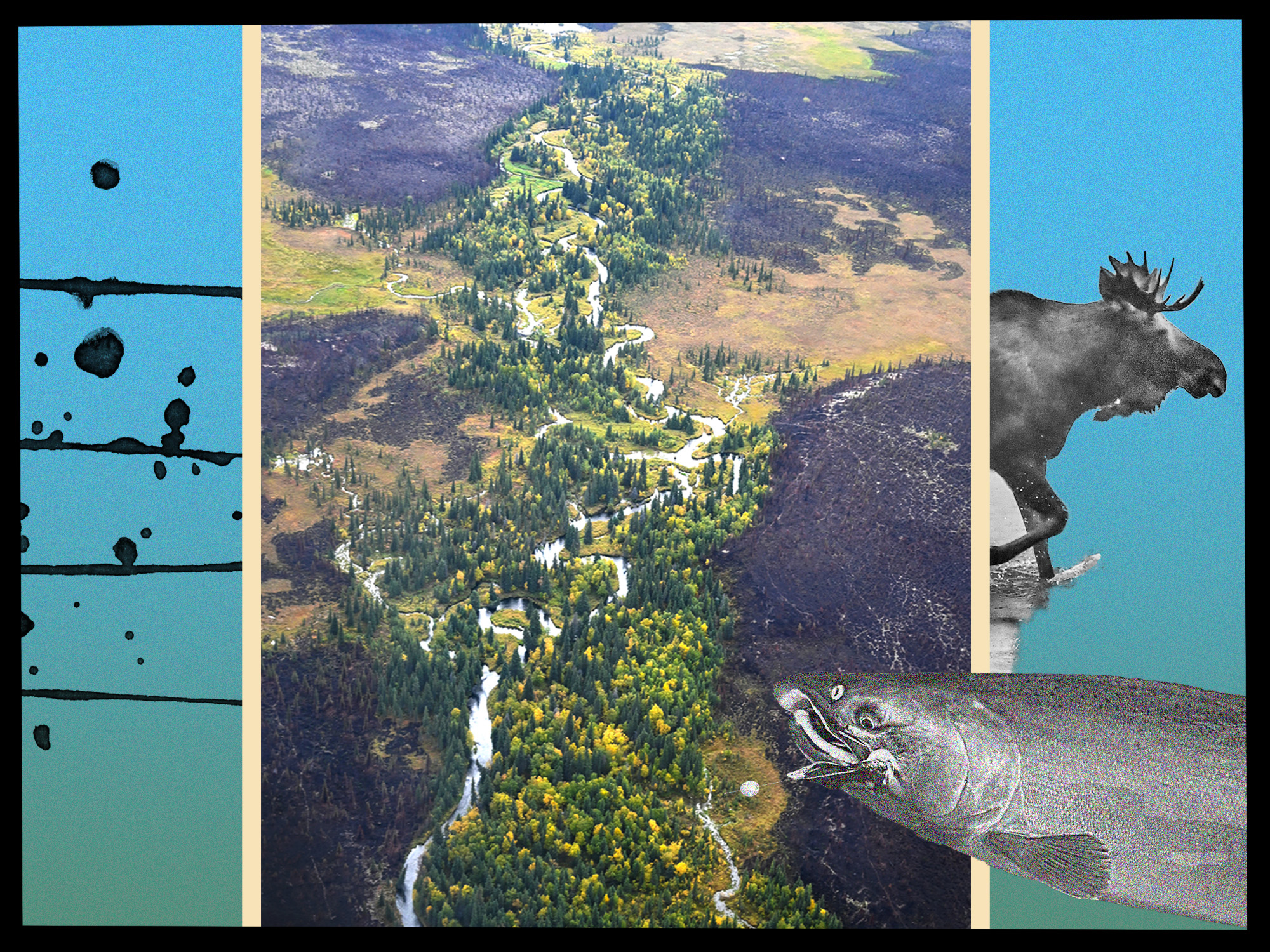“IT’S ALL BURNED UP,” Chad Hewitt shouts over the Beaver’s roar, briefly lifting one hand off the flight controls to wave across a blackened expanse. “Everything’s gone.”
I met Steve, veteran gill net captain and owner of Pride of Bristol Bay, a direct-from-the-fishery wild Alaska salmon business, just six months before this hunt. We bonded over shared backgrounds in commercial and fly fishing, and a fondness for traditional archery and nasty wilderness adventures. He was looking for a moose-hunting companion this fall, and I raised my hand.
“The mine camp was over there, or what’s left of it,” Hewitt says as we toss dry bags and raft parts onto the spongy lakeshore. “They tried to cut a fire line around the buildings and drilling gear, but it jumped.”
This summer, the Upper Talarik fire ripped through 9,000 acres of trees and tundra, demolishing the Pebble Partnership’s exploratory mining facilities. Nearly 300,000 more acres burned just to the west during one of the hottest, driest Alaskan summers on record. But compared to stiff political headwinds, a few torched Quonset huts are only minor setbacks for the Canadian mining corporation. Northern Dynasty Minerals, Pebble’s owner and parent company, is likely flying in a holding pattern until those winds shift in its favor again.
Hewitt has seen this cycle play out many times before. He first came to the Bristol Bay region in 1993, a few days after graduating high school and shortly after one of the world’s largest deposits of copper and gold was discovered here. Hewitt started as a fly-fishing guide but fell in love with flying. Now 47, he co-owns three fishing lodges, a rafting business, an air taxi company, and a remote fishing camp on the hallowed Lower Talarik Creek. Even with all those businesses to manage, he still flies his immaculate de Havilland Beaver every day.
To Hewitt, the Pebble Mine remains an existential threat. “It’d completely change all of this,” he says. “My livelihood would be done.”
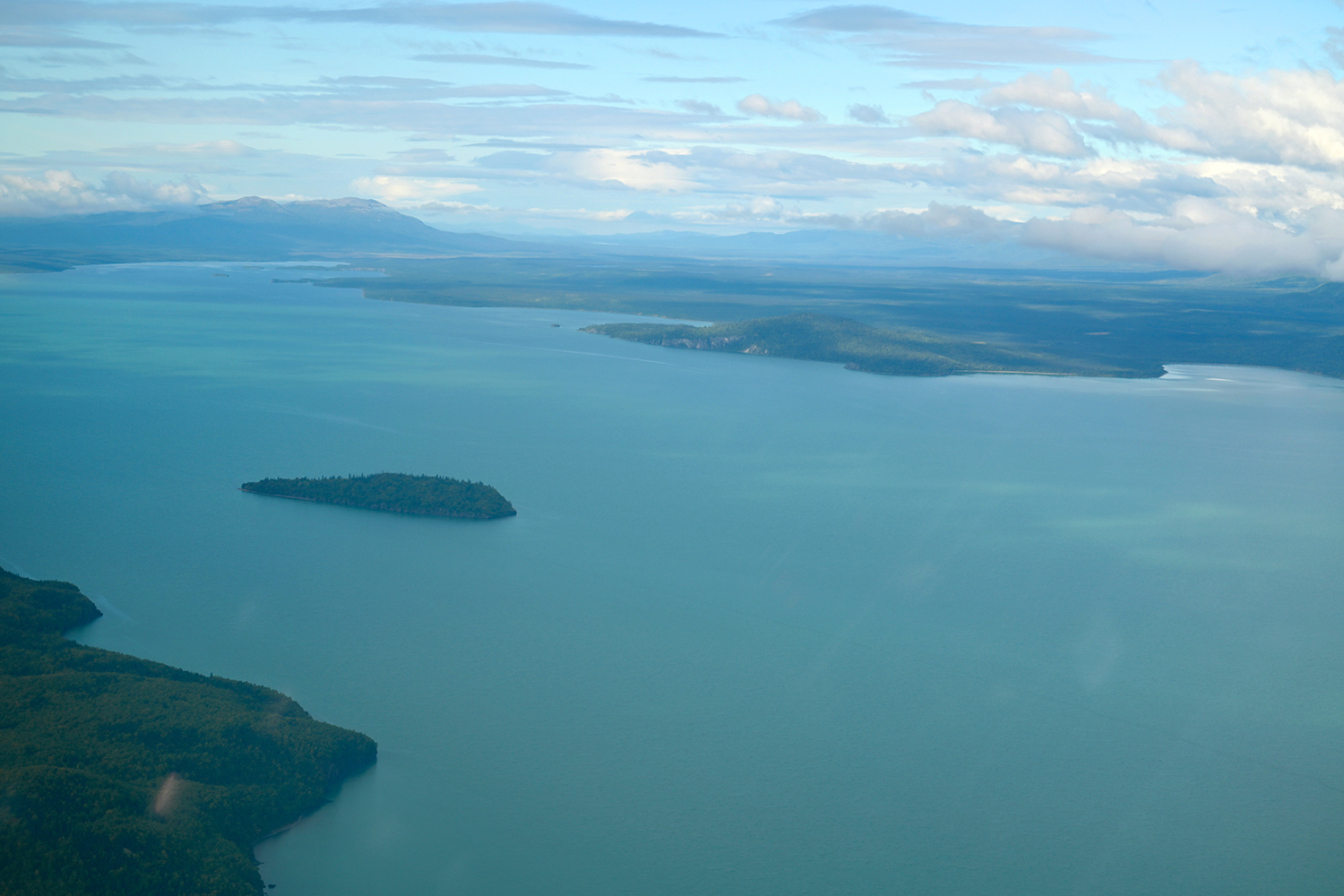
“You guys didn’t bring much stuff,” Hewitt comments idly, untying the plane and glancing over our gear. Steve and I lock eyes with looks of dismay bordering on panic. We packed light on purpose—should we have brought more stuff?
“OK, good luck!” Our pilot waves, drifting away in the de Havilland.
Before either of us knows it, or we really know each other, we’re watching Hewitt’s floatplane disappear over the horizon, leaving us alone in the wilderness.
On Tundra Time
We inflate the raft and drag it to the river, sweating in our waders after maneuvering the 15-foot boat through gnarled bank-side alders. As we return to the pond, a caribou comes over the rise on the other side. Ears erect, the crusty old bull trots our way to get a better look, then beds to watch us haul another load of gear. He’s gone when we make a third trip.
The river flows shallow and gunmetal gray as I assemble my Seek Outside Tipi Tent on a grassy bank, pondering Hewitt’s intel that no one has floated this stream in four years due to low water and logjams. Camp arranged, we string our bows and set out to glass and call. Steve and I both aspire to make a traditional bow kill, but I brought a rifle just in case. The principal goal is to bring home meat, to make a success of this harebrained adventure. Moose season opens tomorrow, so we head out to scout—and look for the ptarmigan we heard chuckling earlier.
A nearby rock field affords a view of a braided section of river, and Steve wails through his birch-bark cone like a lonely cow. We peer into the cottonwoods for an hour before I decide to walk around the pond to survey our route downriver. A band of mottled ptarmigan sail off a weathered bluff ahead, and I nock a blunt-tipped arrow. One tall head remains as I creep to 20 yards. The shaft brushes the bird and vanishes into spongy tundra moss forever.
From a promontory beyond, miles of tundra give way to forests of cottonwood, birch, then spruce as the landscape slouches toward Bristol Bay. Mountains constrict the valley some 20 miles off, bisected by scars from wildfire. So much ground to cover, I think.
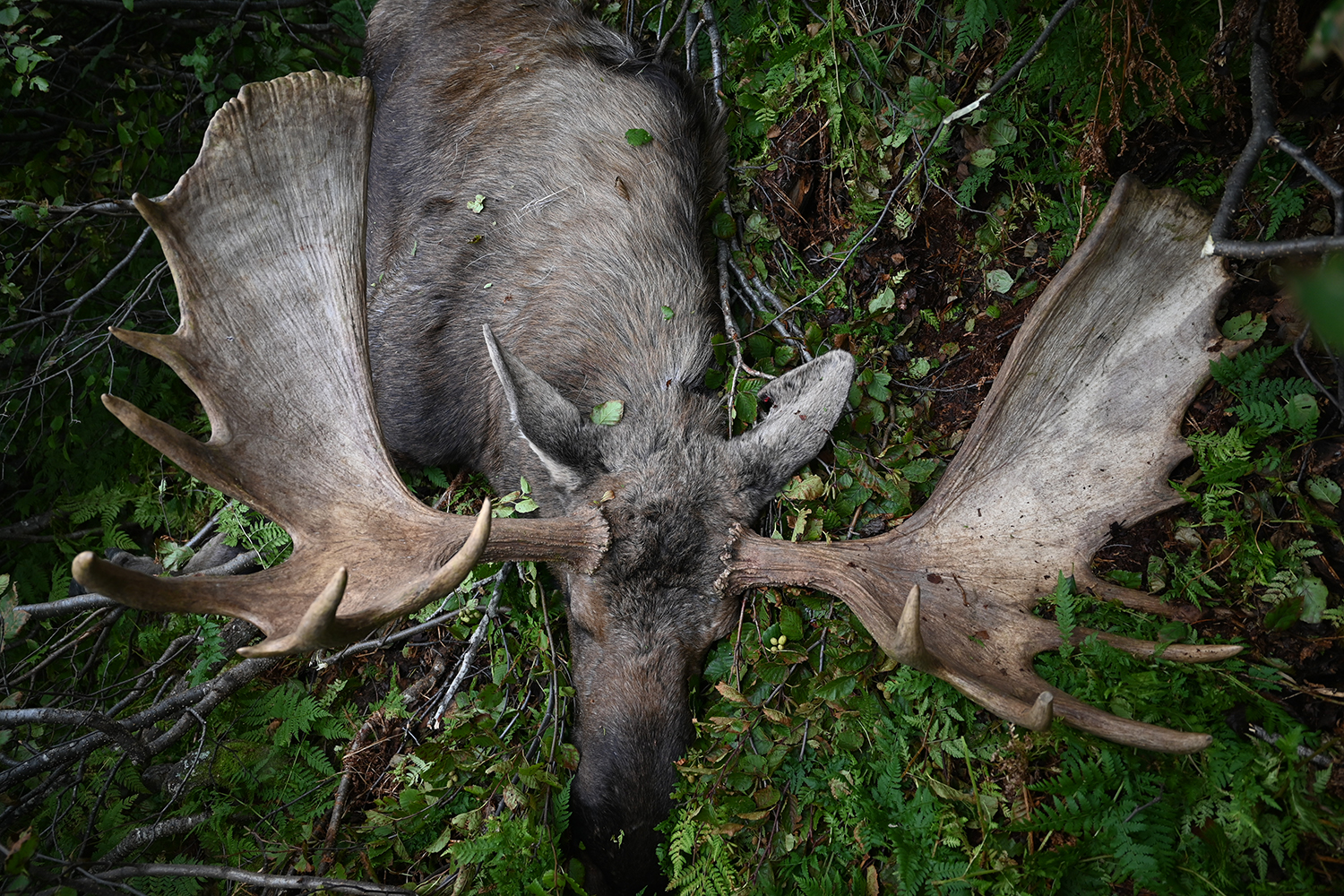
I return to the moraine expecting Steve has seen as many moose as I have. Instead, he vectors my spotting scope to a meadow where a young bull appears to be pestering a cow. A good omen but no opportunity in this unit, which permits nonresidents to kill bulls with only four or more brow tines or a 50-inch spread. We return to the tent as the light dissolves.
Rain patters on the tent as we gear up with that edginess reserved for opening morning. So much moisture lingers that we can barely glass for five minutes from the moraine without wiping lenses. Index fingers to my nose and thumbs on my throat, I bawl my loudest nasal moan across the tundra.
The fog and drizzle clear enough for us to see up the valley, but the moose we spotted have moved on. Restless after two hours of glassing, Steve wanders toward camp for a fresh angle. I hear him gasp from 30 paces.
“Bull,” he exhales. “Big bull. Back by the tent.”
I rush over to train the spotting scope on the gray-brown dot moving steadily up the far side of the valley. The word steroids flashes oddly in my mind as a neck and expansive shoulders come into focus. There’s no doubt this heavyset moose is legal.
I cow-call again and the bull slows, lifting his head in acknowledgment. We run to the river to set an ambush, only to find our knee boots insufficient for the rising current. Steve keeps watch while I jog to the tent for our waders (and my bullets). I hear him call pleadingly as I hustle back. Donning waders, he points to where the bull veered up a hillside covered in old-growth alders. We ford the stream and spot the moose again, glaring and alert to our grunts and wails but otherwise unmoved. After hustling higher to the edge of the thicket, I begin bashing a log against a tree to imitate a bull raking his antlers. The moose takes a few steps and vanishes.
We call for an hour, then retreat to the river for a better view. But this landscape, which looked so flat and gentle from the Beaver’s window, can apparently hide an animal too tall to walk under a NBA basketball hoop.
Eventually we decide to bushwhack up the mountain. A high knob above the trees gives us the elevation we want, but we can’t see through the thick brush. I need to get in there and bird-dog this three-quarter-ton pheasant.
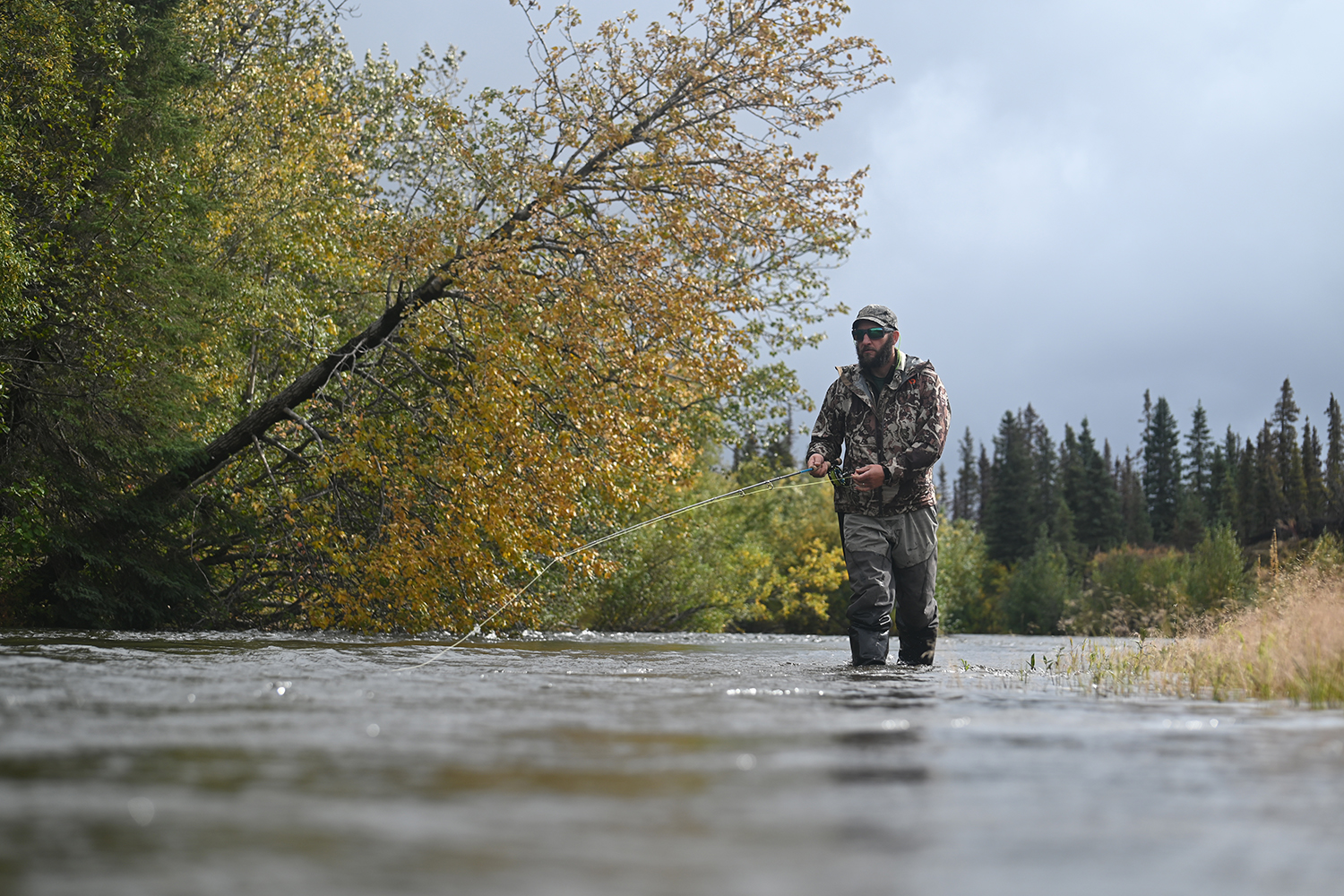
With my rifle across my back, I drop back to the treeline. Creeping among volcanic rubble and impenetrable jungle, I glass every gap in the vegetation, calling as I go. A few hundred yards puts me well past where we last saw the bull, so I turn and again reach a rise. I grunt as loudly as my lungs can manage. Ivory tips spring above the greenery.
I grunt again. The paddles lower and trees dance. I jog uphill to try to see Steve, but when I turn around, the antlers are gone. I mentally mark the spot and hike high enough that Steve notices my jumping-jack wave. Minutes later, he arrives with his bow but not mine.
Oh well, I think, no time to waste.
We thread our way through alders separating strips of moraine for 150 yards until I motion to Steve to slow.
“I’m pretty sure he’s only about 30 yards past these rocks,” I whisper.
Steve sneaks to the edge and nocks an arrow. I hang back to call, climbing a big rock and racking a round for good measure. Filling my chest with air, I punch out a hard “ERRUH.”
Antlers rise fast. The bull corrects my intonation with a deeper, more nasal grunt. He smashes through trees as he comes uphill. Just before running out of cover, he stops. For five long minutes, he rakes alders and answers calls. Steve stands ready at 12 yards but can see nothing more than antlers. Finally, the bull continues inside of the treeline as he works downwind. Steve looks to me, curling his index finger in and out as if pulling an invisible trigger.
“Do you have a shot?” he whisper-shouts. “He’s gonna wind us. Shoot him if you can!”
I reposition myself higher on the rock until I can just see a sliver of hide. As I settle behind the scope, the moose steps forward enough to expose the crease behind his shoulder, and I fire.
The bull spins and smashes off, bulldozing alders thick as my leg. The report of my follow-up shot echoes with a tremendous crash below. As Steve and I climb back to our packs, a strange remorse briefly floods me.
That could have been Steve’s archery opportunity. And you have another eight damn days out here, I think. Then my better angels reply. I’m pretty sure that’s the kind of bull you do not let get away.
A Mine in the Morass
That night, I feed the collapsible wood stove to dry clothes and braise backstrap in butter while trying not to cramp up. From where I lie on my sleeping bag, it’s about a mile to the kill. Another handful of trackless miles beyond that sits the proposed location for two mine tailings storage facilities. The closest, to be built without a lining, would store up to 1.15 billion tons of waste rock. The second would be lined to prevent up to 150 million tons of tailings and “potential acid-generating,” or PAG, waste from leaking into nearby rivers.
An embankment dam 265 feet tall would rise to a towering 545 feet during the proposed 20-year lifespan of the mine. Once the mine closed, PAG waste would be transferred to an open pit, under the water table, which “eliminates all potential for downstream failure impacts,” according to the Pebble website. (The partnership did not respond to multiple requests for comment.)
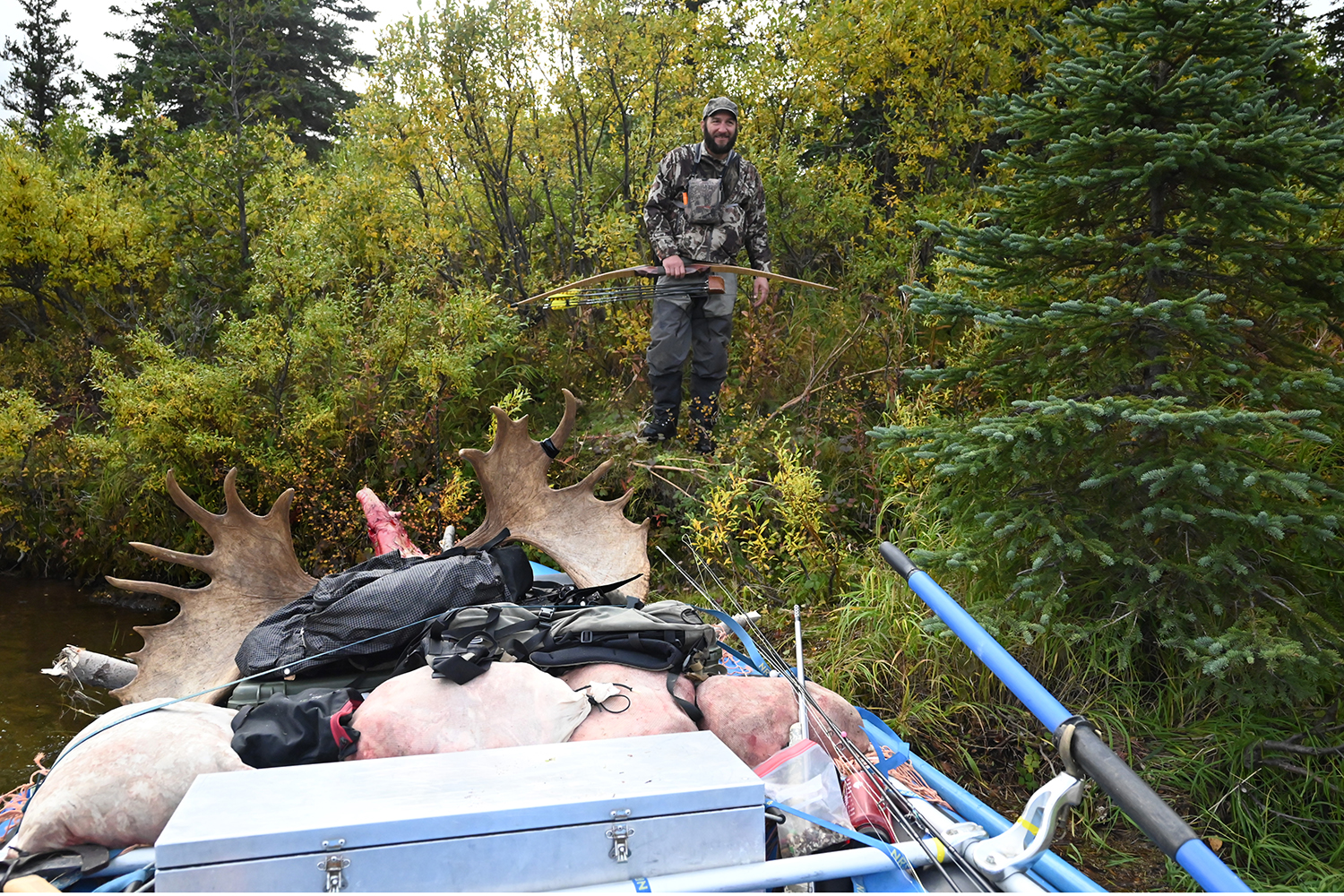
The pit, which could become the largest in North America, would sit in a high saddle dividing three headwater streams that drain toward Bristol Bay. Any environmental mishap could affect two major watersheds that annually welcome tens of millions of sockeye salmon, plus runs of four more salmon species and other game fish. Many conservationists worry acid drainage could wind up in these waterways through porous soil or a tectonic shift. The Lake Clark fault lies less than 20 miles away.
But even the world’s cleanest mineral-extraction operation in this untouched wilderness would displace game. My moose likely wouldn’t have been rutting here if the adjacent 5 square miles contained a mine. Multiple studies have found moose and caribou typically distribute away from roads and human noise, even if they’re not being hunted. Roads fragment habitat and separate populations. And once there’s one road, spurs will branch off it.
Mining’s impact on big game and other terrestrial critters hasn’t been studied as well as its impact on fish. We do know a 2022 report found that American game has lost, on average, 6.5 million acres of vital habitat to development over the past two decades. Of those species, moose lost the most: one out of every 93 acres in their range. There’s even some indication that Pebble has already affected ungulates. Subsistence hunters said noise during Pebble’s exploration phase “disturbed moose populations and altered caribou migration patterns,” the EPA reported in 2018.
If the mine is permitted—which seems vanishingly unlikely—developers would first need to reach its location. That would require a road to the neighboring villages of Iliamna and Newhalen across the massive Newhalen River, several more streams, and 20 miles of untracked tundra. From there, they’ve proposed either two ports to cross the oceanic Lake Iliamna or a 60-mile road around it. Developers also envision a 165-mile natural gas pipeline to power the mine. The Conservation Fund is currently under contract to buy 44,000 acres of conservation easements from the Pedro Bay Corporation, effectively preventing the construction of that road. But that hurdle is just one of many the project currently faces.
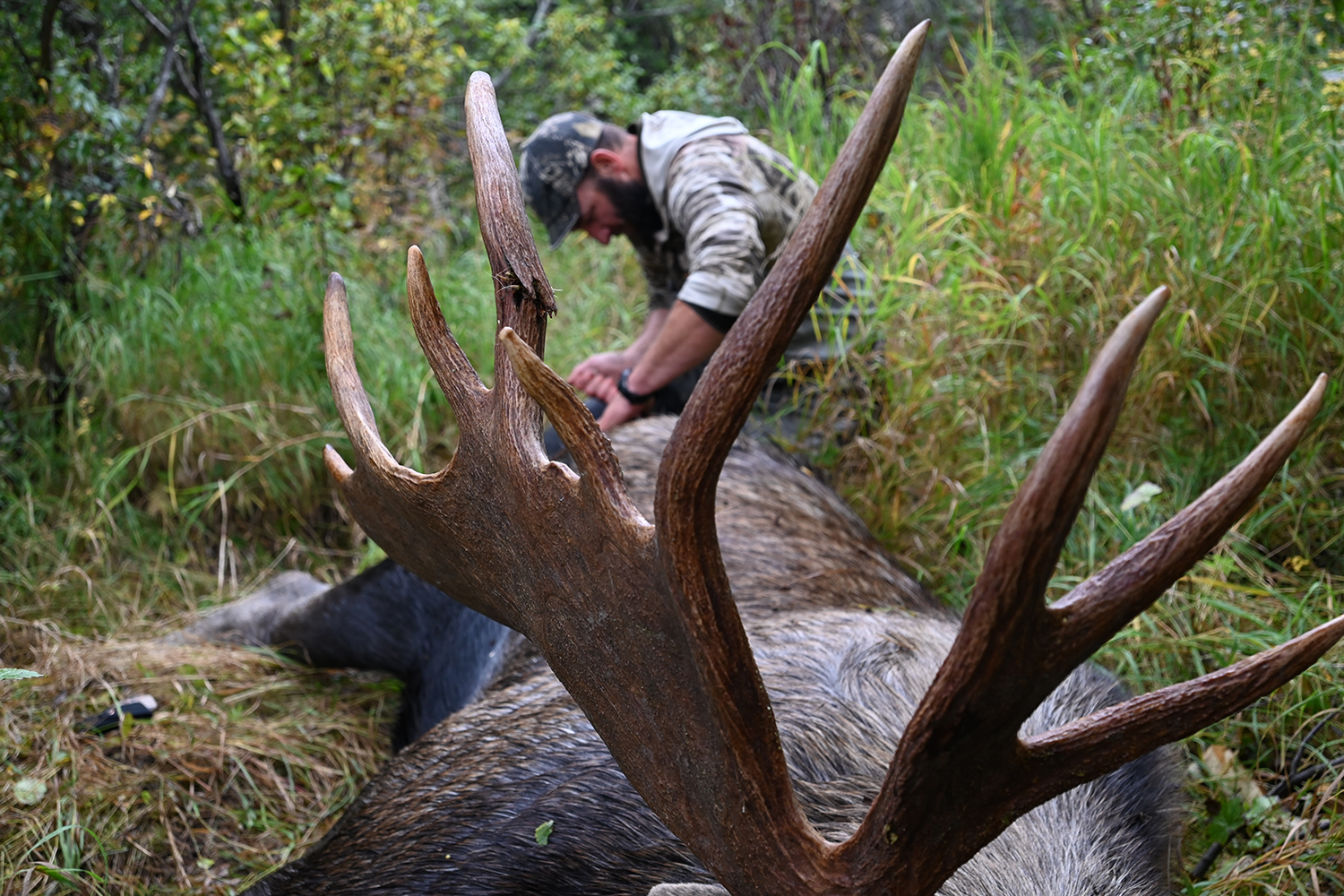
In May 2022, the EPA proposed to use its authority under the Clean Water Act of 1972 to prohibit developers from using, changing, or discharging into nearby streams. The agency received more than 500,000 public comments on this proposal and released a recommendation on Dec. 1 that will functionally veto the project—for now.
Still, that process has been reversed before. (The battle over the proposed mine has a three-decade history.) Conservationists have been lobbying Congress to pass a bill that would effectively kill Pebble. Optimists say the Pebble project is already dead. Others say it was never more than an elaborate ploy to fleece investors. Still more people believe the mine will find a way.
Doubling Down
A few straggler sockeyes swim ghostly and fading in the deeper holes. The high tundra stream forces us to negotiate rock gardens and shallow bars before dropping faster into cottonwood and willow country. But it clearly flooded hard this spring, and none of the logjams or strainers block the entire stream.
We stop at intervals to call and glass, reaching a major confluence some 10 miles down by early afternoon. Steve hooks a 5-pound “silver” salmon sporting a fierce kype and blood-red war paint. We release the coho, reckoning we have plenty of meat already. Steve lands his second nice grayling near a fallen spruce, and I catch another a few holes down. The river is rising and perfectly stained with overcast skies and spawning salmon—looking ideal for trout.
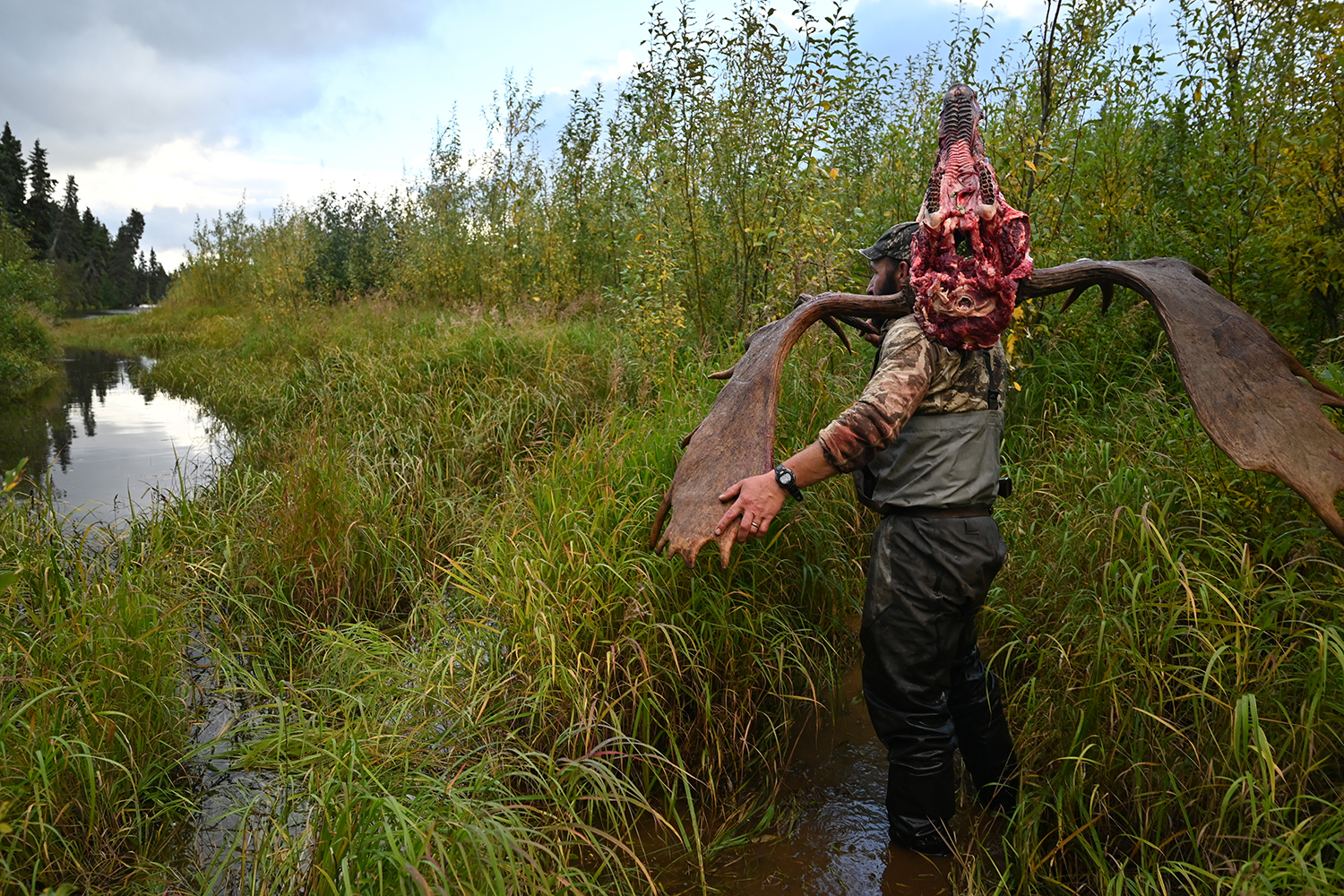
We float on, aiming for wetlands that stretch across the map like the roots of a tree. At a grassy bank up the outflow, we pitch the tent near a pile of brown bear scat and take turns calling near the ponds until dusk. The next day brings tight channels and logjams that force us to pull over and scout, but I’m able to shoot the chutes each time.
The forest feels endless and impossibly dense, and I wonder how we’ll ever find another moose in it. It’s that sheer wildness of this place that makes the possibility of a mine so offensive to so many people, so discordant with a landscape that has eluded development. Steve wonders aloud what a mine would mean for these moose, this river, and his ability to catch the salmon downstream that he ships to people across the country.
Sometime midafternoon, we eddy out. I grunt three times before lying back on a gamebag and drifting off.
A nasal shock wave smacks me from across the river. “ERRUH.” I sit up, spinning with vertigo as a wide bull storms out of the willows. Steve and I freeze as the moose squints at us from barely 60 yards out. He seems to see the moose rack on the rather moose-shaped, albeit bright blue, NRS raft. I lift my binoculars carefully.
“Three and two brows, but he is wide,” I whisper. “What do you want to do?”
“He’s definitely 50,” says Steve, glancing from his binos to his bow. My own eyes dart to the rifle strapped behind me.
It’s amazing the moose is still standing there, and I wonder if it’s ever seen a human before. Still, a traditional archery opportunity is nonexistent. I slip the scope cover off my rifle and rack a round before slowly passing it to Steve. As the bull turns to go, the muzzle-braked barrel discharges.
“I didn’t hear an impact.”
Steve mouths words at me and I find an explanation in my temporary deafness.
“I think it was a good shot,” Steve says, louder this time.
We agree to wait 45 minutes; we last 15. It’s later than we’d like, and the urge to find blood in daylight is strong. I row across the river, and we wade into the flooded willows. No blood. We work into a slough, then a game trail that disappears into the fathomless spruce. No blood.
Steve climbs the high bank first. As I follow, he hoots with joy.
“Holy shit, here he is!”
We walk up on an animal more brown than my own gray tundra bull. His antlers are thinner but wider, with long spider tines laid broad and flat. One is partially broken from a recent run-in with another moose or a tree. Steve, who normally wears a grin from ear to ear, looks like his face might crack.
Return From Paradise
Frost glitters on the ground the following morning, and we decide to make a run for it. It’s only 25 miles to our pickup point, we reason.
The rowing proves easy early on, and we strip, drift, and drag a variety of flies. A swimming brown bear reverses course upon seeing us round the bend, then sprints into the woods. We see the first jet boat soon after, heading upriver with jugs of gasoline crammed in the hull. Later, we pass the river’s only cabin.
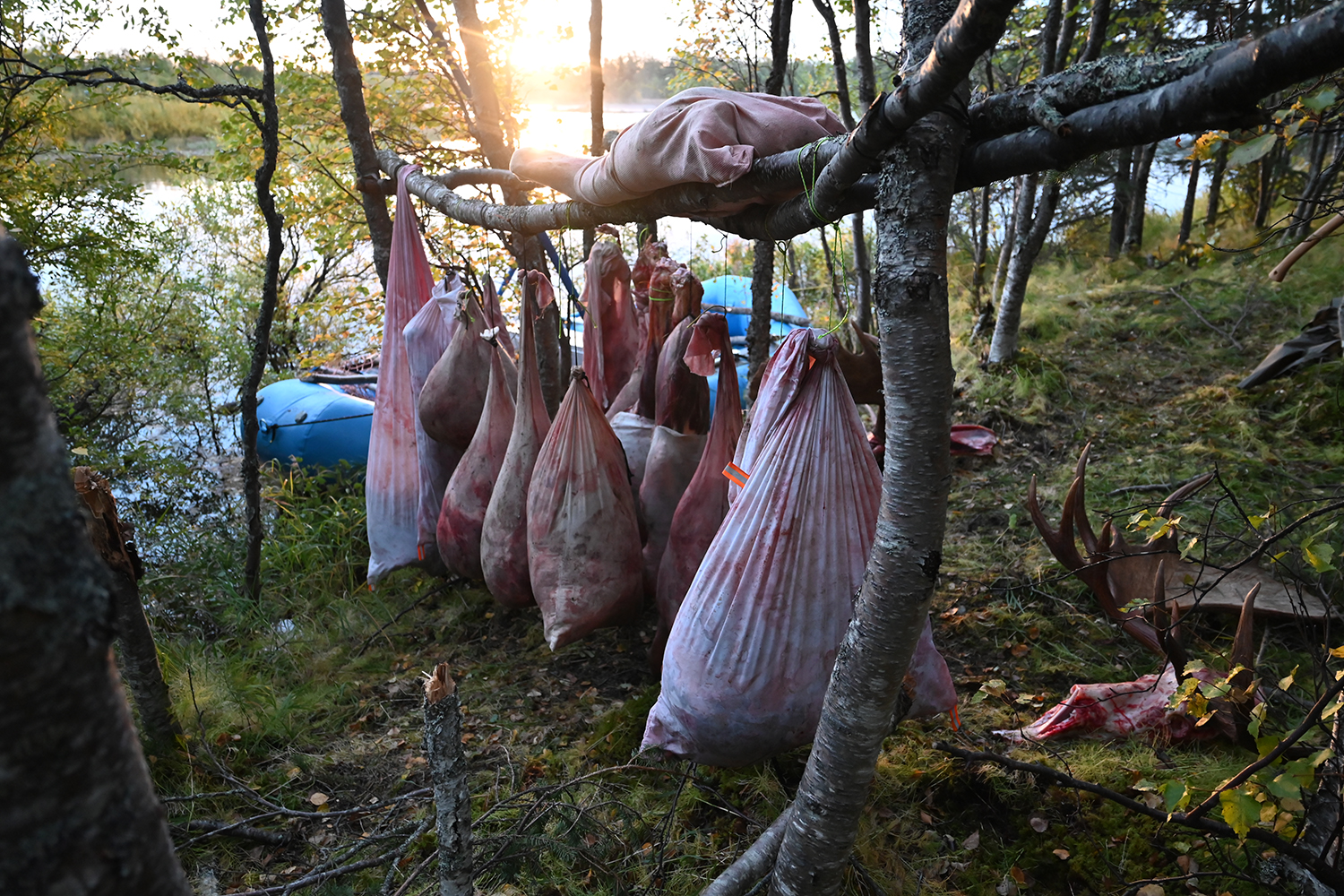
“Wow, you guys really did it,” he says, seemingly amazed we didn’t fail or die.
Upon arrival in Iliamna, we learn it’s customary for visiting hunters to donate a portion of their meat to the Native tribe. That’s how we meet Trefin Andrew at his home outside town. We park between a towering, trailered Bristol Bay gill net boat and a truck bed already loaded with moose quarters. The 58-year-old is busy deboning meat to distribute to elders, widows, and families in need.
“People appreciate that,” Andrew says, flashing a big Athabaskan smile. “Some of them can’t get out and hunt, so [this] gives them some meat for the winter. It’s been working.”
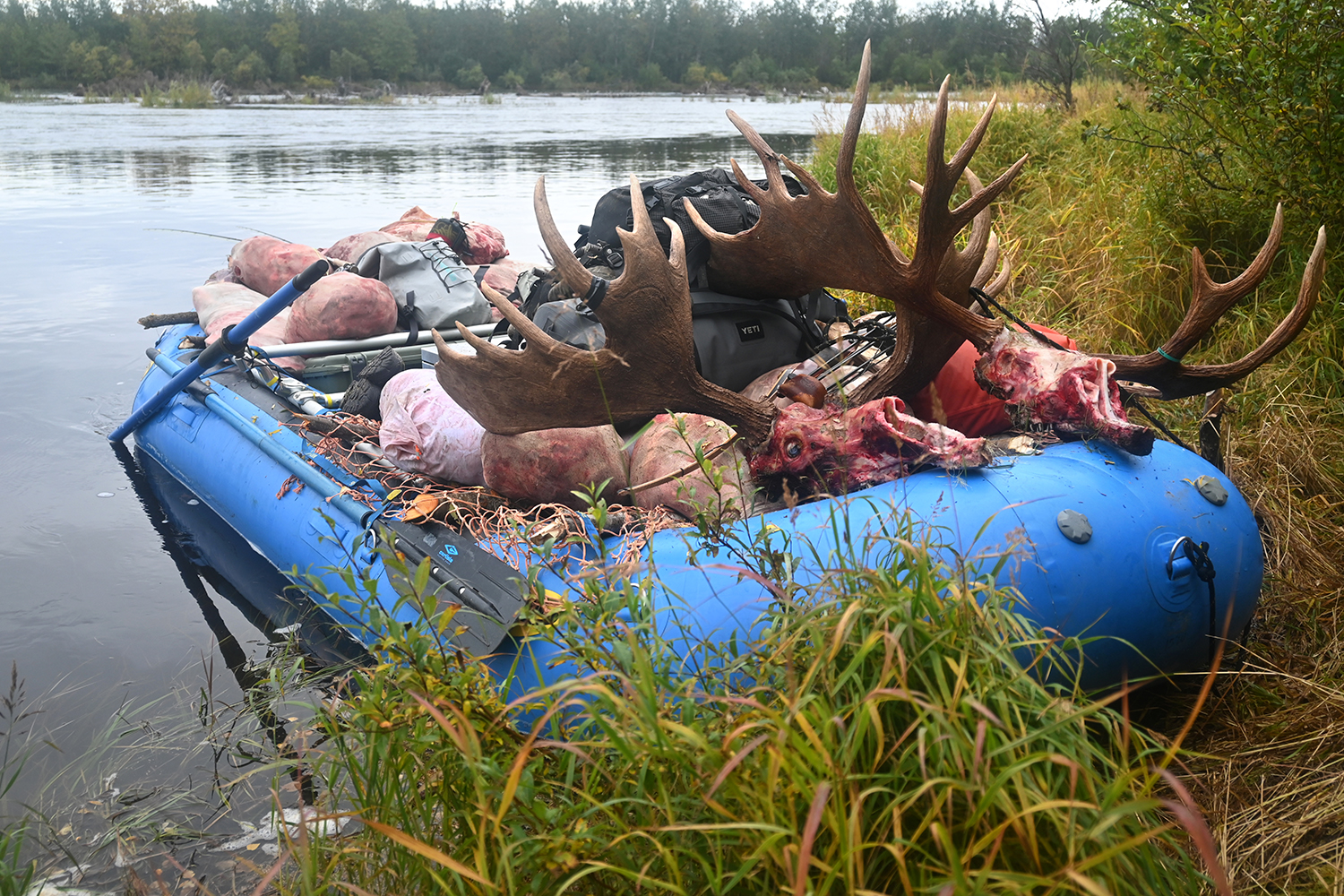
Poverty is a major problem for these villages—one of many reasons he’s in favor of the Pebble Mine.
“There’s some families that are less fortunate, don’t have the Bristol Bay [gill net] permit, can’t afford to get one,” Andrew says. “So I view [the mine] as opportunity for them to work, give some economic resource for our region, because there are a lot of them that are just sitting back, relying on government handouts. Where’s the pride in that?”
When people are working, Andrew says, they’re happy. They can afford new vehicles, snow machines, and boats, and they can participate in the subsistence harvest because they can afford gas. He thinks the mine will happen someday, even if it’s not in his lifetime. All the outside focus on Pebble’s risks to Natives, he says, has conveniently focused on tribes nearer the ocean and farther from the copper deposit, who depend more heavily on salmon for food and income. A 2015 study by the Alaska Department of Fish and Game found that the subsistence harvest in the Bristol Bay area was among the largest in the state.
“We still do our subsistence activity, but we still want to be pro–economic development,” Andrew says. “We just can’t rely on salmon only, we gotta have other revenues.”
“Everything will still be the same. We’ll still have our animals, our fish. All this technology, it’s amazing what they can do. It’s not like back in the early years,” he says. “But it would be an eye-opener [for there] to be a gigantic hole there. A lot of people travel that place and hunt.”
One hang-up for Andrew is the idea that Pebble could be only the beginning of a massive mining district. Developers have privately expressed interest in expanding to nearby deposits, possibly even the greenlighted Donlin gold mine 150 miles northwest of here.
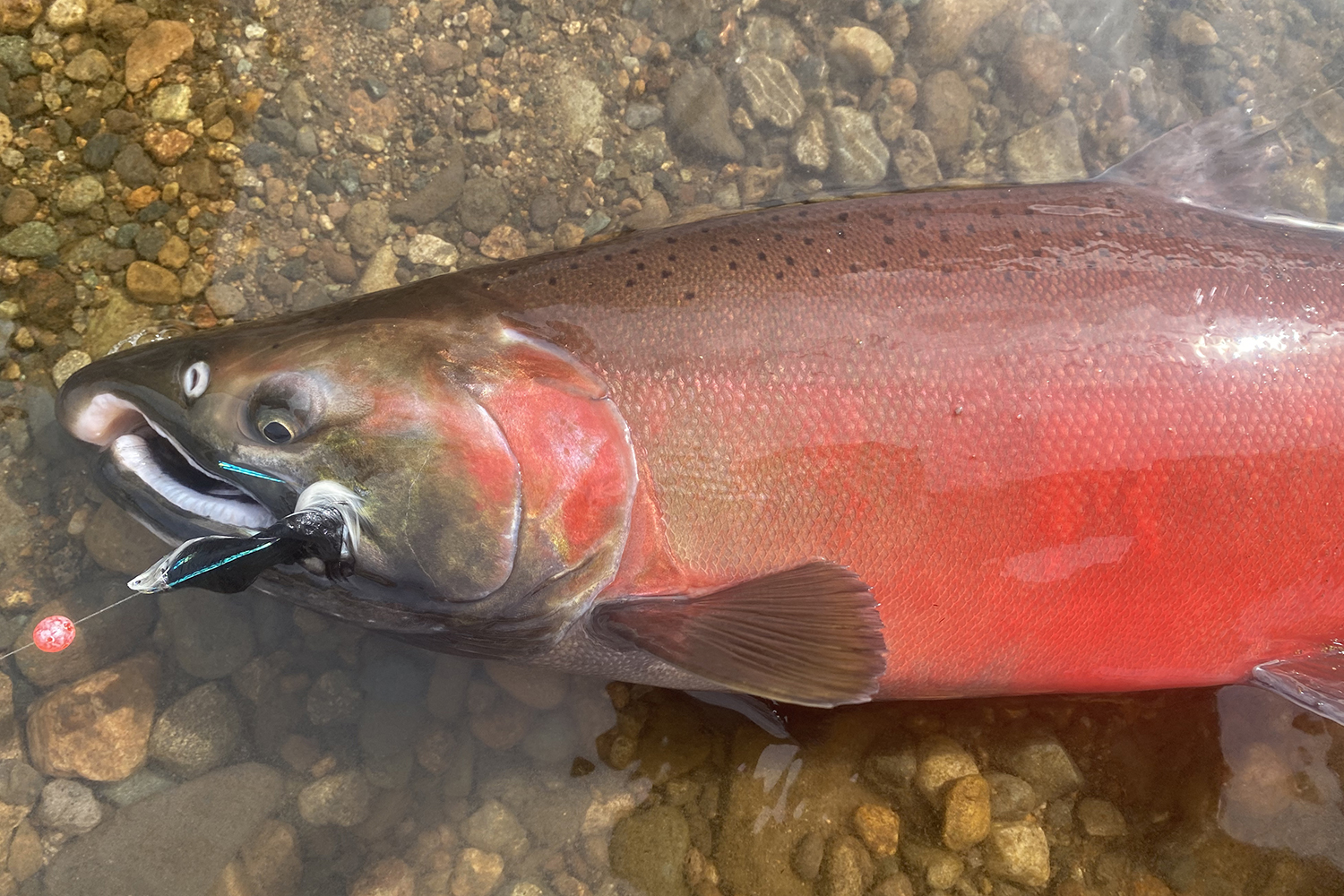
“I’ve seen some people that were pro-development and once they heard that, they kind of went the other way,” says Andrew, who remains troubled by families leaving the village to find work elsewhere. “I tell everybody, ‘You just try to educate yourself and make your own decision. Don’t listen to everybody else. We’re the ones that live here.’”
An Unspoiled Place
A dozen USGS maps detailing the vastness of southwest Alaska are stitched together on the back wall of Hewitt’s guide shack in Iliamna. Steve and I drop by after grabbing $25 hamburgers—a reminder of what it costs to live here and why Andrew is concerned about local jobs and sharing venison.
Mining jobs pay well. So do fishing jobs, which currently dominate the region’s employment and income despite being fickle and seasonal. Even Hewitt wonders what future tech might pollution-proof a mine. Some locals point to other mines in Alaska that are generating local wealth, tax revenue, infrastructure, and critical minerals without extirpating nearby fish and game. Outside of catching fish and seeing bears, there’s no economic activity here now.
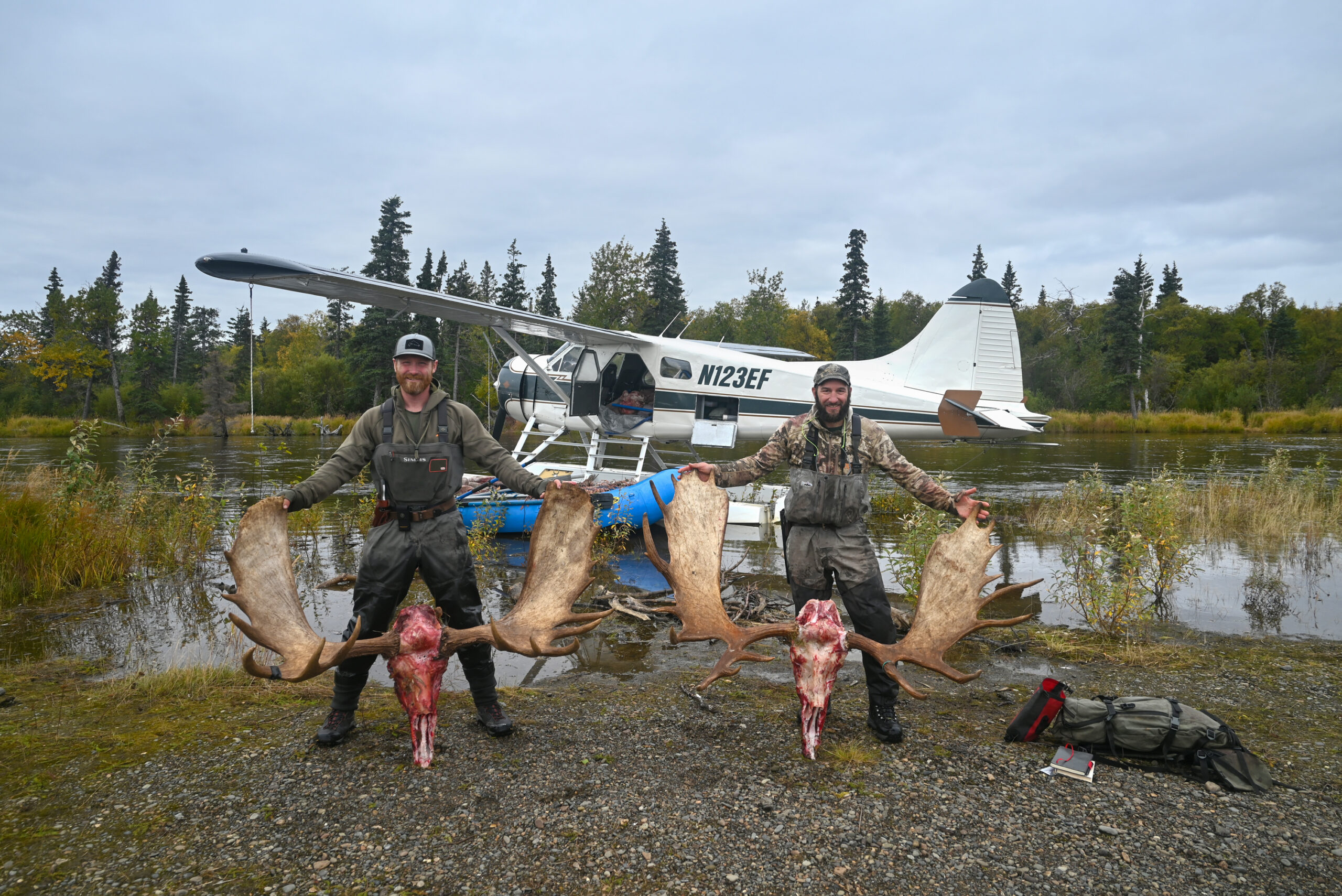
Still, there are precious few empty landscapes where we haven’t gone and built something. To Steve and Hewitt, that big blank place on the maps tacked to the wall is everything. It sustains their bodies, their bank accounts, their souls. Before we depart, a silent agreement passes between them: to remain vigilant to the threat of a mine, no matter what.
“They say, ‘Oh, the Clean Water Act is going to fix it forever,’” Hewitt says. “The fact is there’s gold in those hills and there’s a lot of people who want it. Someone’s always going to want it. The fight will never go away.”
Read more OL+ stories.
